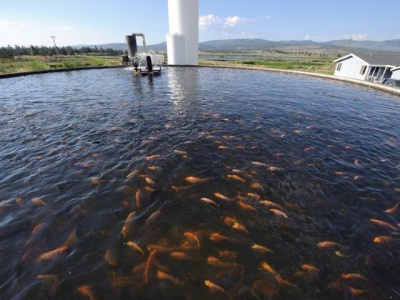Nutritional study aims to decrease aquaculture mortality

University researchers believe they have come up with a valuable feeding option that will lower fish mortality rate in US feeding systems
With a three-year grant from the National Oceanic and Atmospheric Administration’s (NOAA) National Aquaculture Program, Chris Langdon plans to work on a way to deliver water-soluble nutrients to aquaculture-raised fish such as yellowtail, seabass and Pacific halibut in cooperation with the Hubbs SeaWorld Research Institute.
Langdon is professor of fisheries at Oregon State University's Hatfield Marine Science Center.
As much as 80 percent of hatchery-reared larval marine fish die in their early life stages and researchers aren’t exactly sure why, Langdon told New Food Magazine.
“We’re having some success by packaging water-soluble nutrients into liposomes that we use to enrich the live feeds – for example, brine shrimp – or put inside of food pellets,” Langdon said. “The next step is to expand the project and look at how it affects different fish species, and whether we can make it cost effective,” he told the magazine.
As the world population grows, the importance of aquaculture also grows. Over time, Langdon believes adding nutrients and other components in the fish feed will decrease fish mortality and make it easier for the U.S. to supply its own seafood. This may also have an impact on the price of seafood in the U.S.
“Higher production of healthy fish larvae will reduce costs for hatcheries that should be passed onto consumers. Production of healthy 'seed' is a major bottleneck for marine finfish aquaculture,” he said.
Healthier larvae
Other health issues that affect the mortality rate in fish may also be impacted by this better nutritional plan.
“Disease is always a concern. But healthy larvae fed on an improved diet will help the larvae overcome infections. It might also be possible to deliver vaccines and immune-stimulating substances to improve larval resistance to diseases,” Langdon said.
With the modern fear of anything modified in human food, some could question if liposomes with other substances, such as growth-promoting agents, vaccines, or vitamins to boost the animals’ immune systems and reduce stress, could be a problem from a marketing standpoint.
“My view is that hormones and antibiotics would not be acceptable additions for fish that will end up on the dinner plate but could be useful in maintaining valuable broodstock (that are not be eaten but only used for egg production), assuming this approach was acceptable to” the U.S. Food and Drug Administration (FDA), Langdon said.
He added that vitamin supplements for fish larvae should be acceptable by most consumers, but again FDA may need to review this application.
As Langdon and his team of researchers continue to move forward on their mission to decrease the mortality rate in aquaculture, they will be posed with the following major question Langdon said: “How the costs of liposomes production equates with hatchery cost savings due to increased production of healthy larvae.”
Có thể bạn quan tâm
 Plenty of opportunities for Vietnamese pangasius exports to ten CPTPP countries
Plenty of opportunities for Vietnamese pangasius exports to ten CPTPP countries Vietnamese pangasius exports to ten CPTPP countries were worth 328.4 million USD, up 17.3% as compared to the previous year. Exports to most countries grew
 Bac Lieu promotes shrimp brand to the world
Bac Lieu promotes shrimp brand to the world In order to promote the image and brand of Bac Lieu shrimp products to the world, on June 29, in Ha Long City, Quang Ninh province
 Vietnam to establish shrimp alliance
Vietnam to establish shrimp alliance Cà Mau will boost the chain production, build global certified cultured shrimp farms and promote the community surveillance in this sector.